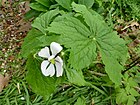Note: This is a project under development. The articles on this wiki are just being initiated and broadly incomplete. You can Help creating new pages.
Difference between revisions of "Sinopodophyllum - Laghu patra"
(→Uses) |
|||
| Line 4: | Line 4: | ||
==Uses== | ==Uses== | ||
| − | {{Uses|Cancer}}, {{Uses|Ovarian cancer}}, {{Uses|Snakebites}}, {{Uses| | + | {{Uses|Cancer}}, {{Uses|Ovarian cancer}}, {{Uses|Snakebites}}, {{Uses|Liver disorders}}, {{Uses|Skin eruptions}}, {{Uses|Blotches}}, {{Uses|Pimples}}, {{Uses|Diarrhea}}, {{Uses|Sore throats}} |
==Parts Used== | ==Parts Used== | ||
Revision as of 15:08, 11 January 2019
Sinopodophyllum is an herbaceous perennial plant in the family Berberidaceae and described as a genus by Linnaeus in 1753. It is widespread across most of the eastern United States and southeastern Canada.
Contents
- 1 Uses
- 2 Parts Used
- 3 Chemical Composition
- 4 Common names
- 5 Properties
- 6 Habit
- 7 Identification
- 8 List of Ayurvedic medicine in which the herb is used
- 9 Where to get the saplings
- 10 Mode of Propagation
- 11 How to plant/cultivate
- 12 Commonly seen growing in areas
- 13 Photo Gallery
- 14 References
- 15 External Links
Uses
Cancer, Ovarian cancer, Snakebites, Liver disorders, Skin eruptions, Blotches, Pimples, Diarrhea, Sore throats
Parts Used
Chemical Composition
Isopicrodeoxypodophyllotoxin, 3beta-hydroxy, 7alpha-methoxy, 24beta-ethyl, cholest-5-ene, 7beta-hydroxysitosterol , beta-sitosterol, daucosterol, alpha-glyceryl palmitate, alpha-D-glucose, 5-hydromethyl furaldehyde[1]
Common names
| Language | Common name |
|---|---|
| Kannada | |
| Hindi | Ban kakri |
| Malayalam | |
| Tamil | |
| Telugu | |
| Marathi | NA |
| Gujarathi | NA |
| Punjabi | NA |
| Kashmiri | NA |
| Sanskrit | Laghu patra, Vanavrintaka |
| English | Himalayan Apple, Indian apple |
Properties
Reference: Dravya - Substance, Rasa - Taste, Guna - Qualities, Veerya - Potency, Vipaka - Post-digesion effect, Karma - Pharmacological activity, Prabhava - Therepeutics.
Dravya
Rasa
Tikta (Bitter), Kashaya (Astringent)
Guna
Laghu (Light), Ruksha (Dry), Tikshna (Sharp)
Veerya
Ushna (Hot)
Vipaka
Katu (Pungent)
Karma
Kapha, Vata
Prabhava
Habit
Identification
Leaf
| Kind | Shape | Feature |
|---|---|---|
| Simple | Alternate | Leaves are rounded in outline, 10-25 cm long, deeply cut into 3 ovate, toothed lobes, sometimes further lobed |
Flower
| Type | Size | Color and composition | Stamen | More information |
|---|---|---|---|---|
| Unisexual | 2-4cm long | white or pale | 6 | Flowering: May-August |
Fruit
| Type | Size | Mass | Appearance | Seeds | More information |
|---|---|---|---|---|---|
| 2.5-5 cme | Fruit is a large scarlet or reddish berry | many | {{{6}}} |
Other features
List of Ayurvedic medicine in which the herb is used
- Vishatinduka Taila as root juice extract
Where to get the saplings
Mode of Propagation
How to plant/cultivate
Prefers a moist peaty soil and filtered light or shade[111, 187]. Grows well in a moist open woodland[28, 31, 200]. Hardy to about -20°c[3]
Commonly seen growing in areas
Scrub forest areas, Alpine meadows, Humus rich soils, Himalaya region.
Photo Gallery
References
External Links
- Ayurvedic Herbs known to be helpful to treat Cancer
- Ayurvedic Herbs known to be helpful to treat Ovarian cancer
- Ayurvedic Herbs known to be helpful to treat Snakebites
- Ayurvedic Herbs known to be helpful to treat Liver disorders
- Ayurvedic Herbs known to be helpful to treat Skin eruptions
- Ayurvedic Herbs known to be helpful to treat Blotches
- Ayurvedic Herbs known to be helpful to treat Pimples
- Ayurvedic Herbs known to be helpful to treat Diarrhea
- Ayurvedic Herbs known to be helpful to treat Sore throats
- Herbs with Fruits used in medicine
- Herbs with common name in Hindi
- Herbs with common name in Sanskrit
- Herbs with common name in English
- Habit - Perennial herbs
- Index of Plants which can be propagated by Seeds
- Index of Plants which can be propagated by Cuttings
- Herbs that are commonly seen in the region of Scrub forest areas
- Herbs that are commonly seen in the region of Alpine meadows
- Herbs that are commonly seen in the region of Humus rich soils
- Herbs that are commonly seen in the region of Himalaya region
- Herbs




